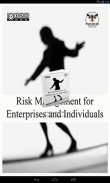




Risk Management

Risk Management介绍
This textbook is designed to reflect the dynamic nature of the field of risk management as an introduction to intermediate-level students. The catastrophes of the first decade of the new millennium, including the credit crisis of 2008–2009, are well depicted and used to illustrate the myriad of old and new risks of our times. With such major man-made and natural catastrophes, this field is of utmost importance for sustainability. The need to educate students to consider risks at every phase in a business undertaking is central, and this textbook provides such educational foundation.
This field requires timeliness as new risk management techniques and products are being developed in response to risks derived from innovations and sophistication. As such, this book allows the reader to be on the forefront of knowledge in the arena of risk management. Tomorrow’s leaders in business and politics and tomorrow’s citizens, consumers, and voters need to understand risks to make successful decisions. This book provides you with the background for doing so.
With the pedagogical enhancements and the ability to make changes dynamically, this textbook brings the best to educators. An important advantage of this book’s publication format is that it can be updated in real time online as new risks appear (e.g., pandemic risk, financial crisis, terrorist attacks). Risk management consequences can be discussed immediately.
The management of risk is, essentially, the strategy for surviving and thriving in a volatile, uncertain, complex, and ambiguous world. Prior to the industrial revolution and the advanced communication age, decisions could be made easily using heuristics or “gut level feel” based on past experience.
As long as the world faced by the decision maker was more or less the same as that faced yesterday, gut level decision making worked fairly well. The consequences of failure were concentrated in small locations. Entire villages were extinguished due to lack of crop risk planning or diseases. There were no systemic contagious interlocking risks, such as those that brought the financial markets to their knees worldwide in 2008–2009.
Saylor URL: http://www.saylor.org/books
Creative Commons Attribution-NonCommercial-ShareAlike 3.0 License
Project Fast Hub, http://www.projectfasthub.com
EPUB3Reader, V. Giacometti, M. Giuriato, B. Petrantuono
这本教科书的目的是反映风险管理领域的动态特性作一介绍,以中等水平的学生。新千年的第一个十年的灾难,其中包括2008 - 2009年的信贷危机,以及被描述和用来说明我们时代的新老风险万千。有了这样重大的人为和自然灾害,本场的可持续发展至关重要。要教育学生考虑在每一个阶段风险的业务经营需要的是核心,而这本教科书提供了这样的教育基础。
此字段需要及时作为新的风险管理技术和产品以响应来自创新和复杂衍生风险正在开发中。因此,这本书可以让读者是对知识在风险管理领域的前列。明天的商业和政治,明天的公民,消费者的领导人,选民们需要了解风险,做出成功的决策。这本书为您提供了背景这样做。
随着教学的改进和制作动态变化的能力,这本教科书带来了最好的教育。这本书的出版格式的一个重要优点是它可以实时为新的风险出现(例如流行的风险,金融危机,恐怖袭击)进行在线更新。风险管理后果可以立即进行讨论。
风险管理,本质上,尚存在一个动荡的,不确定的,复杂的,模糊的世界繁荣的战略。在此之前的工业革命和先进的通讯时代,决策可以很容易地使用启发式或“肠级的感觉”根据以往的经验进行。
只要所面临的决策者的世界是作为昨天面对,肠水平的决策或多或少相同的工作相当好。失败的后果集中在狭小的场所。整个村庄被由于缺乏作物风险规划或疾病熄灭。目前还没有系统性传染环环相扣的风险,比如那些在2008 - 2009年带来的金融市场,以自己的膝盖全世界。

























